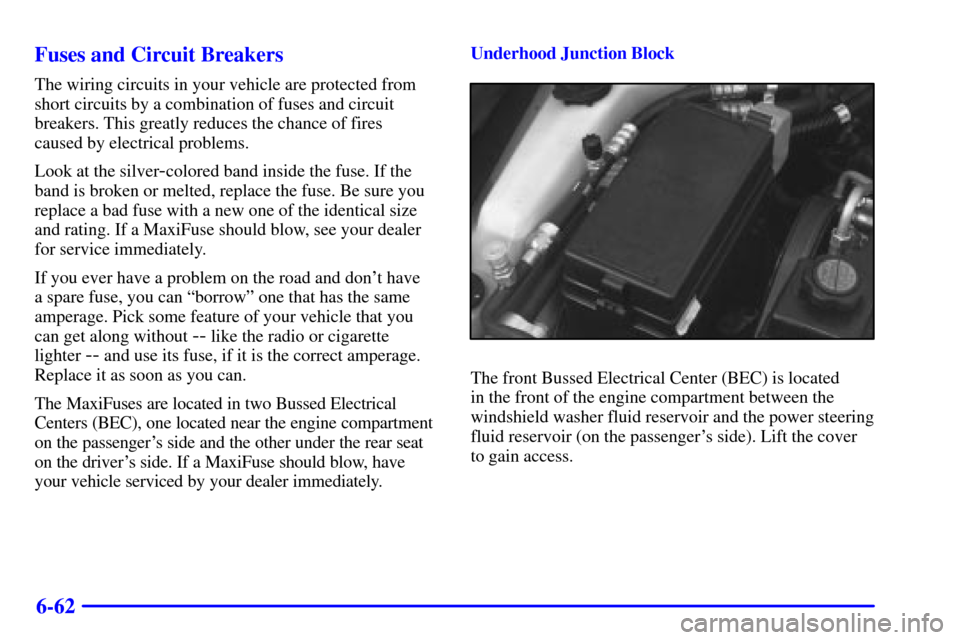Page 277 of 359

6-
6-1
Section 6 Service and Appearance Care
Here you will find information about the care of your vehicle. This section begins with service and fuel information,
and then it shows how to check important fluid and lubricant levels. There is also technical information about your
vehicle, and a part devoted to its appearance care.
6
- 2 Service
6
- 3 Fuel
6
- 5 Filling Your Tank
6
- 8 Filling a Portable Fuel Container
6
- 8 Checking Things Under the Hood
6
- 11 Engine Oil
6
- 16 Engine Air Cleaner/Filter
6
- 19 Automatic Transaxle Fluid
6
- 22 Engine Coolant
6
- 25 Surge Tank Pressure Cap
6
- 26 Power Steering Fluid
6
- 27 Windshield Washer Fluid
6
- 28 Brakes
6
- 32 Battery
6
- 34 Bulb Replacement6
- 43 Windshield Wiper Blade Replacement
6
- 44 Tires
6
- 52 Appearance Care
6
- 53 Cleaning the Inside of Your Vehicle
6
- 54 Care of Safety Belts
6
- 55 Cleaning the Outside of Your Vehicle
6
- 57 Cleaning Tires
6
- 59 GM Vehicle Care/Appearance Materials
6
- 60 Vehicle Identification Number (VIN)
6
- 60 Service Parts Identification Label
6
- 61 Electrical System
6
- 68 Removing the Rear Seat Cushion
6
- 69 Replacement Bulbs
6
- 69 Capacities and Specifications
6
- 70 Normal Maintenance Replacement Parts
Page 286 of 359
6-10
When you open the hood, you'll see:
A. Windshield Washer Fluid
B. Power Steering Fluid
C. Engine Oil Fill Location
D. Engine Oil Dipstick LocationE. Brake Master Cylinder
F. Transaxle Dipstick/Fill Location
G. Engine Air Cleaner/Filter
H. Surge Tank/Coolant Fill Location
Before closing the hood, be sure all filler caps are on properly. Then pull the hood down and close it firmly.
Page 302 of 359

6-26
Power Steering Fluid
The power steering fluid
reservoir is located next
to the fuse relay center
on the passenger's side
of the engine.
When to Check Power Steering Fluid
It is not necessary to regularly check power steering
fluid unless you suspect there is a leak in the system or
you hear an unusual noise. A fluid loss in this system
could indicate a problem. Have the system inspected
and repaired.
How to Check Power Steering Fluid
Turn the key off, let the engine compartment cool down,
wipe the cap and the top of the reservoir clean, then
unscrew the cap and wipe the dipstick with a clean rag.
Replace the cap and completely tighten it. Then remove
the cap again and look at the fluid level on the dipstick.
The level should be at the FULL COLD mark. If necessary,
add only enough fluid to bring the level up to the mark.
What to Use
To determine what kind of fluid to use, see
ªRecommended Fluids and Lubricantsº in the
Maintenance Schedule booklet. Always use the proper
fluid. Failure to use the proper fluid can cause leaks
and damage hoses and seals.
Page 338 of 359

6-62 Fuses and Circuit Breakers
The wiring circuits in your vehicle are protected from
short circuits by a combination of fuses and circuit
breakers. This greatly reduces the chance of fires
caused by electrical problems.
Look at the silver
-colored band inside the fuse. If the
band is broken or melted, replace the fuse. Be sure you
replace a bad fuse with a new one of the identical size
and rating. If a MaxiFuse should blow, see your dealer
for service immediately.
If you ever have a problem on the road and don't have
a spare fuse, you can ªborrowº one that has the same
amperage. Pick some feature of your vehicle that you
can get along without
-- like the radio or cigarette
lighter
-- and use its fuse, if it is the correct amperage.
Replace it as soon as you can.
The MaxiFuses are located in two Bussed Electrical
Centers (BEC), one located near the engine compartment
on the passenger's side and the other under the rear seat
on the driver's side. If a MaxiFuse should blow, have
your vehicle serviced by your dealer immediately.Underhood Junction Block
The front Bussed Electrical Center (BEC) is located
in the front of the engine compartment between the
windshield washer fluid reservoir and the power steering
fluid reservoir (on the passenger's side). Lift the cover
to gain access.